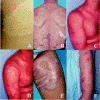Leprosy: a primer for Canadian physicians
- PMID: 14707226
- PMCID: PMC305320
Leprosy: a primer for Canadian physicians
Abstract
Leprosy is a rare but serious infectious disease caused by Mycobacterium leprae. While global prevalence of the disease is decreasing, increasing rates of immigration from countries where leprosy is endemic have led to the recognition of this illness in North America. Classically, leprosy presents as hypopigmented cutaneous macules along with sensory and motor peripheral neuropathies, although the clinical manifestations vary along a disease spectrum. In addition to primary infection, patients may undergo a "reaction," an acute inflammatory response to the mycobacterium, which leads to pain and erythema of skin lesions and dangerous neuritis. Reactions can occur at any time during the course of leprosy, but they tend to be precipitated by treatment. They are a significant cause of impaired quality of life due to marked nerve damage and thus warrant prompt intervention. Although leprosy may have a protracted onset and be difficult to recognize, cure is achievable with appropriate multidrug therapy. Because untreated leprosy can result in permanent, irreversible nerve damage and secondary transmission, early diagnosis and treatment are essential to minimize morbidity.
Figures


References
-
- Centers for Disease Control and Prevention. Summary of notifiable diseases, United States, 1995. MMWR Morb Mortal Wkly Rep 1995;44:73. - PubMed
-
- World Health Organization. Leprosy, global situation. Wkly Epidemiol Rec 2002; 77:1–8. - PubMed
-
- Jacobson RR, Krahenbuhl JL. Leprosy. Lancet 1999;353:655–60. - PubMed
-
- Ooi WW, Moschella SL. Update on leprosy in immigrants in the United States: status in the year 2000. Clin Infect Dis 2001;32:930–7. - PubMed
-
- Fine PE. Reflections on the elimination of leprosy. Int J Lepr Other Mycobact Dis 1992;60:71–80. - PubMed
Publication types
MeSH terms
LinkOut - more resources
Full Text Sources
Medical
